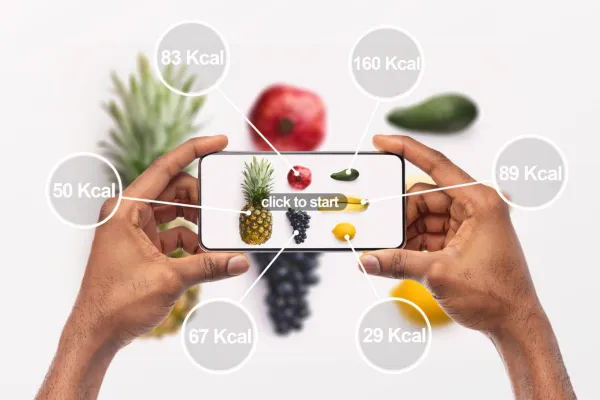Dr. Andrea
Expect Wellness


WELLNESS
Dr. Andrea's
Articles
Growing older can be scary but it doesn’t have to be.
Wouldn’t it be great to embrace your aging and celebrate every single breath you take? As the saying goes – Let’s make the rest of your life – the BEST of your life.

All Calories Are Not Created Equal
All Calories Are Not Created Equal
Many people follow the guideline if you “want to lose weight, you must ingest fewer calories”. In doing so, they trust the calorie specifications on the food label.
At first glance, this seems logical. The body needs a certain amount of energy to maintain, for example, heartbeat, respiration, digestion, and so on. If there is too little fuel to accomplish the tasks, the body falls back on its fat reserves.
A lower calorie intake should therefore melt away the pounds on your hips – but unfortunately it’s not quite that simple.
What is a calorie?
The calorie is a physical unit for energy, work and heat. More than 150 years ago, researchers determined the amount of energy contained in bread, meat, fish or fruit. To do so, they burnt a certain amount of the corresponding food in a steel cylinder (calorimeter bomb) surrounded by water. This combustion process generated heat which heated the surrounding water. This data was meticulously recorded and used to derive how high the energy or caloric value of the various foods was and this was defined as a calorie or kilocalorie.
“A calorie is consequently the amount of energy required to heat one gram of water by 1 °C” – or 1 kilocalorie (kcal) is exactly the amount of heat/energy density required to heat 1 kg of water by 1 °C (from 22 °C to 23 °C). If a slice of pizza has 245 kcal, this means that the energy stored in it is sufficient to heat 245 l of water by one degree Celsius.
Therefore, one might think that it doesn’t matter for body weight whether one consumes a whole apple or drinks the same amount as apple juice instead. However, while the daily consumption of apples is healthy and provides the body with plenty of vital and dietary fiber, the corresponding amount of apple juice contributes in the long run to the metabolism becoming unbalanced, since in particular the abundant sugar enters the blood quickly and upregulates, thus negatively affecting the insulin level.
Scientists are largely in agreement that it does make a difference where the calories come from, in what form, and probably even at what time of day they are ingested. This is because the type and processing of food determine how our digestive tract and the billions of microorganisms that make their home in it utilize the food.
Preparation and consistency influence calories
Scientists have discovered that food does not release its calories to us one to one. For example, the body has to expend a lot of energy to break down and digest raw vegetables or high-fiber foods. If, on the other hand, the vegetables or whole grain products are cooked, the fiber and complex carbohydrates contained are broken down in such a way that the digestive system does not have to expend as much energy. This implies cooked foods provide more calories than raw foods. The longer a food is cooked or processed, the more the structure of the food changes.
Cell walls break down, nutrients are broken down and are more quickly and easily available to the body.
Janet Novotny, a nutritionist at the U.S. Department of Agriculture, and her colleagues have also demonstrated this very impressively using almonds as an example. The usable calorie content of almonds eaten raw was 20 percent lower than that of the same amount of almond paste. When almond paste was consumed, the full calorie count came into play.
Just to save calories, however, you still shouldn’t switch to a raw food-only diet because it can lead to an undersupply of nutrients and digestive problems. A healthy mix of raw foods and gently prepared foods provides optimal nutrition for the body while still being low in calories.
How much the body absorbs from a food also depends on its consistency. A whole grain bread with butter and a “Milchschnitte” (a cake based treat with a ‘milky’ filling) are both rated at around 300 kilocalories per 100 grams. The fact that more calories are nevertheless absorbed from the soft children’s snack and that its “caloric value” is ultimately higher can be explained by the fact that the body has to expend more energy when digesting the wholegrain bread with complex carbohydrates.
Japanese researchers have demonstrated this effect in an experiment with rats: for 22 weeks, they fed one group of the animals the usual grain diet. A second group of rats was fed food with the same number of calories but processed food that required significantly less chewing. The result was that the rats with the “soft food” were obese after the experimental period, while the others were not.
Calories – hunger and satiety
It’s one thing to meet your energy needs. But it’s quite another thing to feel full and satiated in the process. Calories are not nutrients. We can mathematically ingest the appropriate amount of energy, but still remain hungry because our food contains few nutrients.
Even carbohydrates and proteins, which both provide 4 kcal per gram, do not have an identical physiological effect on the body.
Short-chain carbohydrates such as glucose enter the blood quickly, causing blood sugar and insulin levels to skyrocket. The hormone insulin encourages the body’s cells to rapidly absorb sugar from the blood. Once this happens, insulin levels promptly drop – which in turn triggers hunger. While 100 kilocalories from a low-sugar apple are filling, the juice drinker quickly feels hungry again and the desire to eat something, despite the same amount of energy ingested, due to the higher sugar intake.
Protein, on the other hand, leads to long-lasting satiety. In the stomach, proteins are broken down into amino acids, which enter the small intestine and stimulate the hormone production of cholecystokinin, peptide YY and glucagon-like peptide1. These pass into the blood and transmit the signal of satiety to the brain. At the same time, insulin levels remain stable after the consumption of protein-rich meals and cravings are prevented. It is also interesting to note – as studies have confirmed – that almost one third of the calories consumed in the form of protein are burnt off again directly when the proteins are digested.
Metabolic Balance does not count calories!
Instead of paying attention to the number of calories, it makes more sense to look at the quality of the food. Metabolic Balance therefore recommends unprocessed foods that are as close as possible to their natural state. High-quality cold-pressed oils should not be avoided under any circumstances, despite their high energy content. After all, fat is not only an energy carrier, but also indispensable for many metabolic processes in the body. Fish, meat, vegetables, fruit, legumes, mushrooms, nuts or dairy products with a natural fat content provide not only energy but also plenty of fiber, complex carbohydrates and protein, which are jointly responsible for maintaining the body’s functions and have a high satiety value. Thus, they help maintain weight or facilitate weight loss without having to count calories.
Meals composed of fat, protein and fiber-rich vegetables – as recommended by the Metabolic Balance nutrition plans – have a positive effect on blood sugar levels.
At the same time, nutrition according to Metabolic Balance ensures a balanced vitamin and mineral account so that all nutrients can be optimally metabolized. Now at the latest, “all calories are not created equal” – after all, it makes a clear difference to the body whether 300 kcal are consumed in the form of fruit, vegetables and nuts or 300 kcal from foods that are less rich in vital substances, such as potato chips and sweets, which provide hardly any vital substances and make it more difficult for the body to function.
Sources:
Oka, K., Sakuarae, A., Fujise, T., Yoshimatsu, H.,Sakata T, et al. (2003). Food texture differences affect energy metabolism in rats. J Dent Res, 82: 491–494. doi: 10.1177/154405910308200617.
Trivedi, Bijal (2009). The Calorie Delusion: Why food labels are wrong (darin u. a. Interview Geoffrey Livesey), New Scientist. (15 July 2009)
Flores-Mateo, G., Rojas-Rueda, D., Basora, J., Ros, E. & Salas-Salvadó, J. (2013). Nut intake and adiposity: meta-analysis of clinical trials. Am J Clin Nutr, June 2013, 97: 1346-1355. First published online April 17, 2013. doi:10.3945/ajcn.111.031484.





